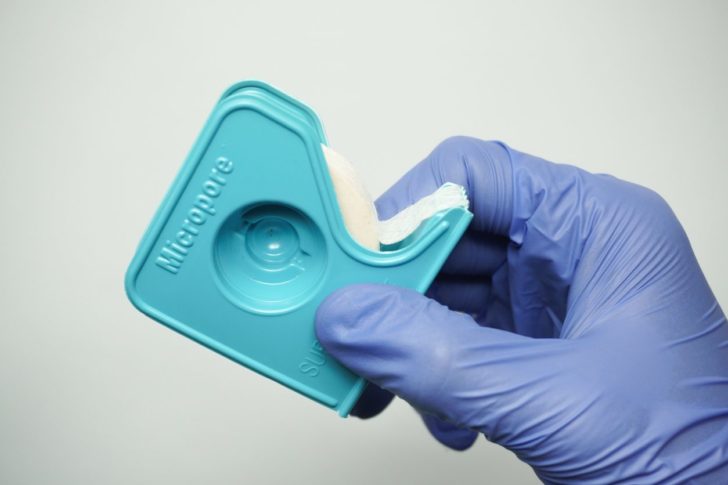Imagine a medical tape that is gentle on your skin, highly breathable, and leaves minimal adhesive residue upon removal. Micropore Tape, a hypoallergenic and versatile tape, has found its way into both medical and personal care fields, offering numerous benefits for wound care, beauty routines, and more. Are you curious to learn more about this wonder tape? Keep reading!
Table of Contents
Key Takeaways
Micropore Tape is a hypoallergenic, breathable medical tape with multiple applications in beauty and medical settings.
It offers gentle adhesion to the skin with minimal residue upon removal, allowing air circulation for wound healing.
Comparing Micropore Tape to other types of tapes reveals its unique features such as gentleness and low risk of allergic reactions.
What is Micropore Tape?

Micropore Tape is a type of medical tape designed to be gentle on the skin while offering secure adhesion for dressings and medical devices. Its features include:
Hypoallergenic nature
Breathability
Secure adhesion
Gentle on the skin
These characteristics have made it a staple in wound care and medical applications, setting it apart from similar items in the market.
Available in various sizes, such as 1/2” x 10 yards, 1” x 10 yards, and 2” x 10 yards, Micropore Tape caters to different needs and purposes. You can find it in white, tan, and even black colors, providing options for various skin tones and preferences.
3M Micropore Surgical Tape
3M Micropore Surgical Tape is specifically designed for general purpose surgical applications. This hypoallergenic tape is crafted from a paper-like material that is gentle on the skin, making it an ideal choice for medical professionals and patients alike.
The merits of purpose breathable surgical tape, such as 3M Micropore Surgical Tape, include:
Hypoallergenic nature
Skin-friendliness
Minimal adhesive residue
Breathable fabric
It adheres effectively to dry skin, making it suitable for general dressing applications, as well as repeated taping on fragile skin.
Types of Micropore Tape
There are various types of Micropore Tape, each designed for specific uses. Some of the available types include:
3M Kind Removal Silicone Tape
3M Micropore Surgical Tape
3M Durapore Surgical Tape
Micropore Paper Tape
These tapes are specially designed for sensitive skin and offer unique characteristics suited for different purposes, such as dressing wounds, affixing medical tubing, or securing medical devices.
Applications and Uses
Micropore Tape has a wide range of applications and uses in medical settings, such as:
Firmly affixing dressings or devices to the skin
Keeping IV catheters and other medical equipment in position
Improving the healing rate of wounds by allowing air to pass through
Its versatility extends to beauty and personal care routines as well, offering advantages like securing lower eyelashes or maintaining the upper eyelid taut.
Medical Use
Micropore Tape is instrumental in medical procedures and wound care. It is utilized in surgical procedures for wound closure and affixing dressings. Its breathability encourages wound healing, and the tape is easy to remove without causing discomfort.
Its gentle yet secure adhesion makes it suitable for:
fragile or elderly skin
mild wounds
cuts
abrasions
pressure sores
However, remember that Micropore Tape is not waterproof, a limitation to consider during wound care.
Beauty and Personal Care
Micropore Tape finds its place in beauty and personal care routines as well. It can be employed to reduce the visibility of wrinkles and fine lines by being applied to specific areas of the face, providing an instantaneous lifting and smoothing effect.
Additionally, it can be used for nail art application to support and secure split nails or create designs using tape in nail art.
In makeup application, Micropore Tape can provide a flat surface for application, avoid smudging or transference, and allow for precise application, making it a handy tool in your beauty arsenal.
Advantages of Micropore Tape
Micropore Tape brings several advantages to the table, including skin-friendliness, breathability, and secure adhesion sans discomfort or irritation. Its hypoallergenic material reduces the chances of experiencing allergic reactions, and it leaves minimal adhesive residue after removal.
These benefits make Micropore Tape a preferred choice in both medical and personal care settings.
Gentle to the Skin
Micropore Tape is hypoallergenic and gentle on the skin, making it suitable for individuals with sensitive skin. The tape is designed to minimize skin irritation in comparison to other medical tapes due to its porous nature, which allows the skin to breathe and thereby prevents irritation.
Scientific and dermatological studies have shown that Micropore Tape:
Is gentle and does not induce skin irritation or damage
Is easy to remove without causing discomfort
Can be changed as required without causing harm to the skin
This allows for flexible and safe use of the box, promoting better health and serving as a removal general purpose solution in stock.
Minimal Adhesive Residue
Micropore Tape leaves minimal adhesive residue, thanks to its composition and design. The tape is composed of a hypoallergenic and latex-free paper-like material that securely adheres to the skin while leaving no sticky residue upon removal.
This feature makes Micropore Tape a more comfortable and convenient option compared to other medical tapes.
Breathable Material
The breathability of Micropore Tape, a type of breathable surgical tape, is another advantage that sets it apart from other medical tapes. Its permeable material allows air circulation, decreasing the likelihood of moisture accumulation and skin irritation. This facilitates wound healing and preserves skin integrity, making Micropore Tape an excellent choice for various applications.
How to Choose the Right Micropore Tape
When choosing the right Micropore Tape, consider factors such as:
Size: available in various sizes (1/2 inch x 10 yards, 1 inch x 10 yards, 2 inch x 10 yards, and 3 inch x 10 yards)
Quantity: choose the amount that suits your needs
Color preferences: available in white, tan, or black
Assess your specific needs and preferences to ensure you select the most suitable Micropore Tape for your requirements.
Size and Quantity
Selecting the appropriate size of Micropore Tape depends on the demands of your specific application. Consider the size of the area that needs to be covered or secured, as well as the degree of flexibility and breathability required. Micropore Tape is available in sizes such as:
1/2 inch
1 inch
2 inch
3 inch
This ensures that you can find the right size for your needs.
When determining the amount of Micropore Tape to purchase, think about factors like:
Frequency of use
Size of the region to be taped
Duration of time for application
Budget
By evaluating these factors, including the price, you can make an informed decision on the pack of tape that best suits your needs.
Color Options
Micropore Tape comes in various colors, such as white, tan, and black, providing options for different skin tones and preferences. While the color of the tape does not affect its functionality or performance, it can impact its visibility on the skin, depending on your skin tone.
Choosing the right color can help make the tape less conspicuous and more comfortable for the user.
Learn more, visit Understanding the Different Types of Medical Tapes.
Tips for Proper Application and Removal
Following proper application and removal techniques for Micropore Tape ensures optimal results. Start with clean and dry skin, apply the tape without stretching or tension, and be gentle when removing the tape to avoid skin irritation or discomfort.
By adhering to these guidelines, you can make the most of your Micropore Tape experience.
Application Techniques
To correctly apply Micropore Tape, follow these steps:
Begin with clean and dry skin to ensure optimal adhesion.
Apply the tape evenly to the desired area without stretching or tension.
Rub the tape firmly into place, applying slight pressure to guarantee proper adhesion.
Following these steps will ensure that your Micropore Tape stays in place and works effectively.
Removal Tips
Gentle and safe removal of Micropore Tape is necessary to minimize skin irritation or discomfort. Soak the taped area in warm water to make it less adhesive and easier to peel off, or use silicone-based adhesive removal products to facilitate the removal process.
Pull the tape back over itself once each section is removed, keeping it close to the skin but not touching anymore. Avoid pulling the tape too quickly or forcibly to prevent potential harm.
Comparing Micropore Tape to Other Medical Tapes
Micropore Tape often finds itself compared to other medical tapes like hypoallergenic paper tape and natural rubber latex tapes. While each tape has its unique features and benefits, Micropore Tape stands out for its gentle nature, breathability, and minimal adhesive residue upon removal.
Understanding the differences between these tapes can help you make an informed decision on the best tape for your needs.
Hypoallergenic Paper Tape
Hypoallergenic paper tape is another type of medical tape designed to be gentle to the skin and suitable for individuals with sensitive skin. Like Micropore Tape, it is breathable and adheres effectively to the skin without causing discomfort or irritation.
However, there are some differences between the two tapes. Hypoallergenic paper tape is typically used for securing small dressings to delicate areas and is often preferred in situations where the patient has sensitive skin or is allergic to latex.
While both tapes offer similar benefits, your specific requirements and preferences will determine which tape is best for you.
Natural Rubber Latex Tapes
Natural rubber latex tapes are adhesive tapes made from natural rubber latex, offering high tackiness and suppleness. They are often used for various applications, such as packaging, bundling, and sealing purposes. These tapes are known for their strong adhesion, unlike Micropore Tape, which provides gentle adhesion and is hypoallergenic and latex-free.
While natural rubber latex tapes have their advantages, Micropore Tape’s breathability and minimal adhesive residue upon removal make it a preferred choice for many users, especially for wound care and medical applications. Ultimately, both tapes have their merits, and the choice depends on the individual’s requirements and preferences.
Summary
In conclusion, Micropore Tape is a versatile and gentle medical tape suitable for various medical and personal care applications. Its hypoallergenic nature, breathability, minimal adhesive residue, and wide range of sizes and colors make it an ideal choice for wound care, beauty routines, and more. By understanding the benefits and differences between Micropore Tape and other medical tapes, you can make an informed decision on the best tape for your needs, ensuring optimal results and comfort.
Frequently Asked Questions
What is micropore tape used for?
Micropore paper tape is commonly used to secure dressings and bandages to skin, without leaving a sticky residue. Its hypoallergenic adhesive sticks to skin, underlying tape, or directly to dressing materials, ensuring it can be safely used for long-term without fear of skin irritation.
What is the difference between micropore and micropore plus tape?
Micropore and Micropore Plus tapes are identical, except for the adhesive. Micropore Plus tape has a higher adhesion to dry skin while maintaining Micropore’s levels of adhesion to damp skin.
What is in micropore?
Micropore is a conformable, non-extensible non-woven fabric made of 100% viscose and coated with an acrylic adhesive. Its breathability allows air to flow through it and dry out wounds, thus helping to improve the healing rate of minor incisions. Additionally, its adhesive properties remain even after limited exposure to water.
Is micropore surgical tape the same as paper tape?
No, paper tape and micropore surgical tape are not the same; paper tape is often referred to as Micropore® tape while transparent tape or plastic tape is referred to as Transpore® tape.
What makes Micropore Tape gentle on the skin?
Micropore Tape is hypoallergenic and composed of a skin-friendly material, making it gentle on the skin by minimizing irritation, discomfort, and allergic reactions. It also leaves minimal adhesive residue upon removal.









